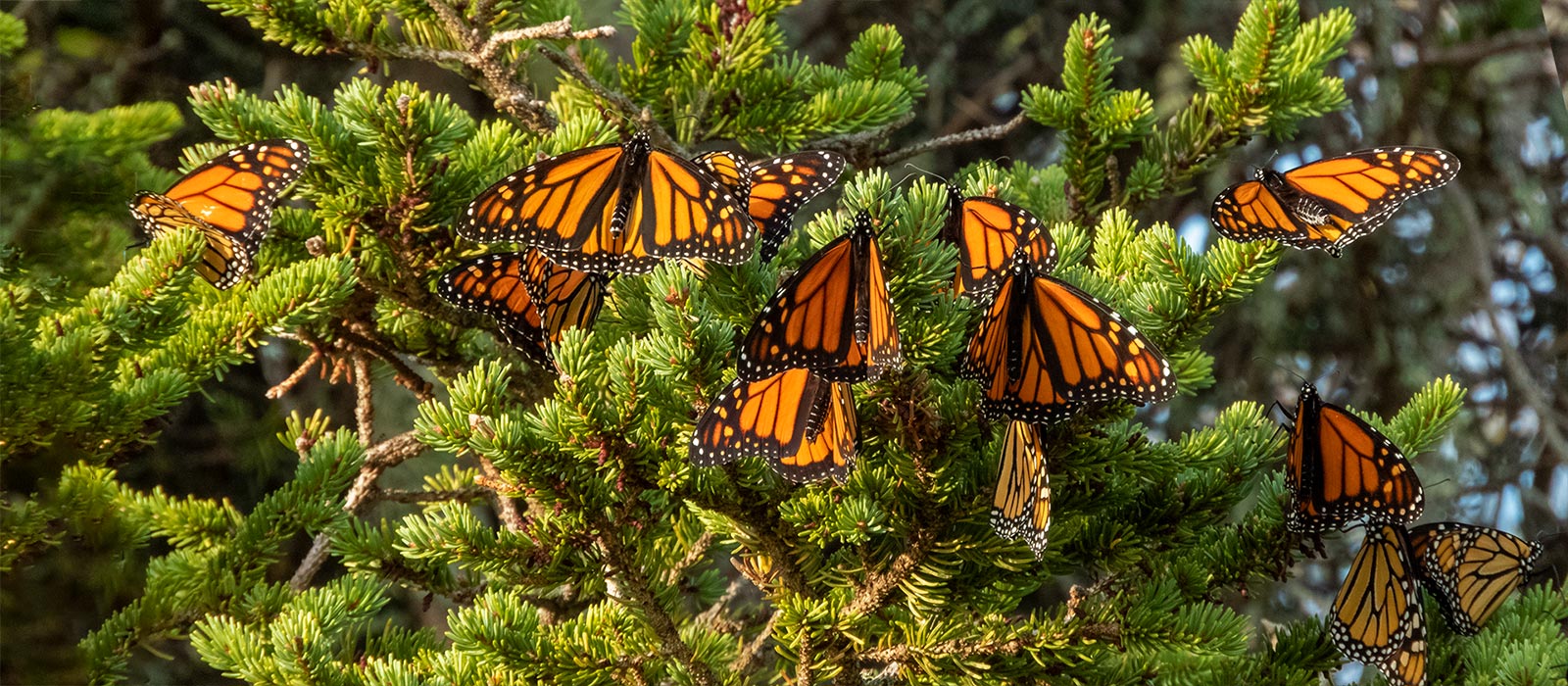
The Monarch Monsoon
An Epic Migration on Monhegan Island
A Monarch on its way to Mexico would seem to have no legitimate business 10 miles out to sea off the Maine coast. The sea here is for Minke Whales and Gray Seals, for Northern Gannets and Herring Gulls — and not a gossamer butterfly weighing little more than a few drops of saltwater.
Try telling that to the thousands of Monarchs here in the Gulf of Maine on Monhegan Island. Monarchs now own the place: a hundred or more nectaring in a patch of tall goldenrod near the Black Duck Emporium, another hundred swarming the mint behind Monhegan House, scores in the courtyard at the Trailing Yew, hundreds more at Lobster Cove. We walk the trails here in the good company of floating orange-and-black escorts. Monhegan is a kingdom of Monarchs.
And at dusk every evening, as we head to the brewery or our families or our bird lists, the Monarchs ascend by the thousands, mostly to the high spruce boughs. They rise not merely to roost for the night, but to preside over Monhegan’s melting pot of souls fortunate enough, during this era of human turmoil, to enjoy one of the planet’s most spectacular migrations at one of its most magnificent places.
Monarchs are here in numbers I have never before seen on this island or, for that matter, anywhere in New England. It’s something I had sort of predicted, particularly after my visit to Monhegan in August, which at the time was lousy with Monarchs producing this very generation of migrants. (My only regret is that my images here in this blog post are feeble and failing expressions for the magnitude of this event.)
Big flights like this can help us learn more about this butterfly and its journeys.
Not only are the Monarchs unmitigated joy, they are data. Lots of it. Although it is one of our most familiar insects, and its migration among the most well-studied, the Monarch (Danaus plexippus) remains in some respects a mystery. Big flights like this can help us learn more about this butterfly and its journeys.
So we’re catching a fraction of the island’s Monarchs, giving each one a tiny sticker with a unique number, and noting its sex, location and the date. And then we release each one to the winds and whims of migration, hoping it will be found again somewhere on its journey south toward Mexico (although many of these coastal migrants probably head toward Florida or the Caribbean, where they join a year-round breeding subpopulation).
We’re also learning about these off-shore migrants. As it turns out, we’re tagging mostly males — about three times as many as females. That skewed ratio could suggest that migrating females in portions of the East might be disproportionally vulnerable to some parasite or other threat. It might suggest that males get blown out to sea more often than females, or even that they both get blown out in similar numbers but that males more easily find their way to safety on island refuges like this one. Maybe males are flying lower and easier to catch during tagging. Or none of the above. I’ll be looking into it — and perhaps publishing with data from this year and others. For now, it’s all wonderful speculation. (By the way, male Monarchs are on average larger than females; the opposite is true among most butterfly species.)
I suspect many of the Monarchs will leave the island today on fresh Northwest winds, along with some of their companions here as well in big numbers: Painted Lady, American Lady and Red Admiral. Perhaps the winds will bring us migrating birds.
To the Monarch watchers waiting to my south: Heed those north winds and scan the skies. A Monarch Monsoon may soon be approaching. Look them over for one of my tags!
Related Reading

Butterflies and Joy
Two hundred orange butterflies in a meadow of purple wildflowers — next to the ocean. It reminds me to slow down, lose the gadgets and find the joy.
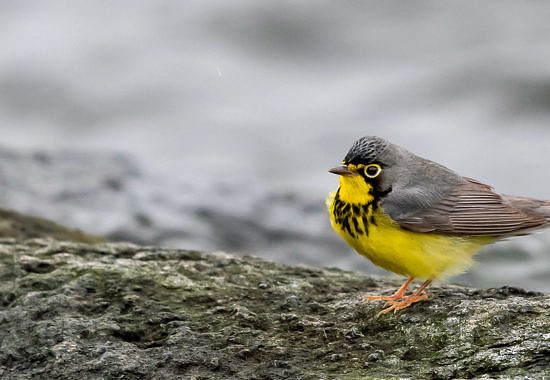
When Songbirds Fall to Earth
Delivered from the fog, the grace and irony of tired warblers feeding at my feet on Monhegan Island, Maine.
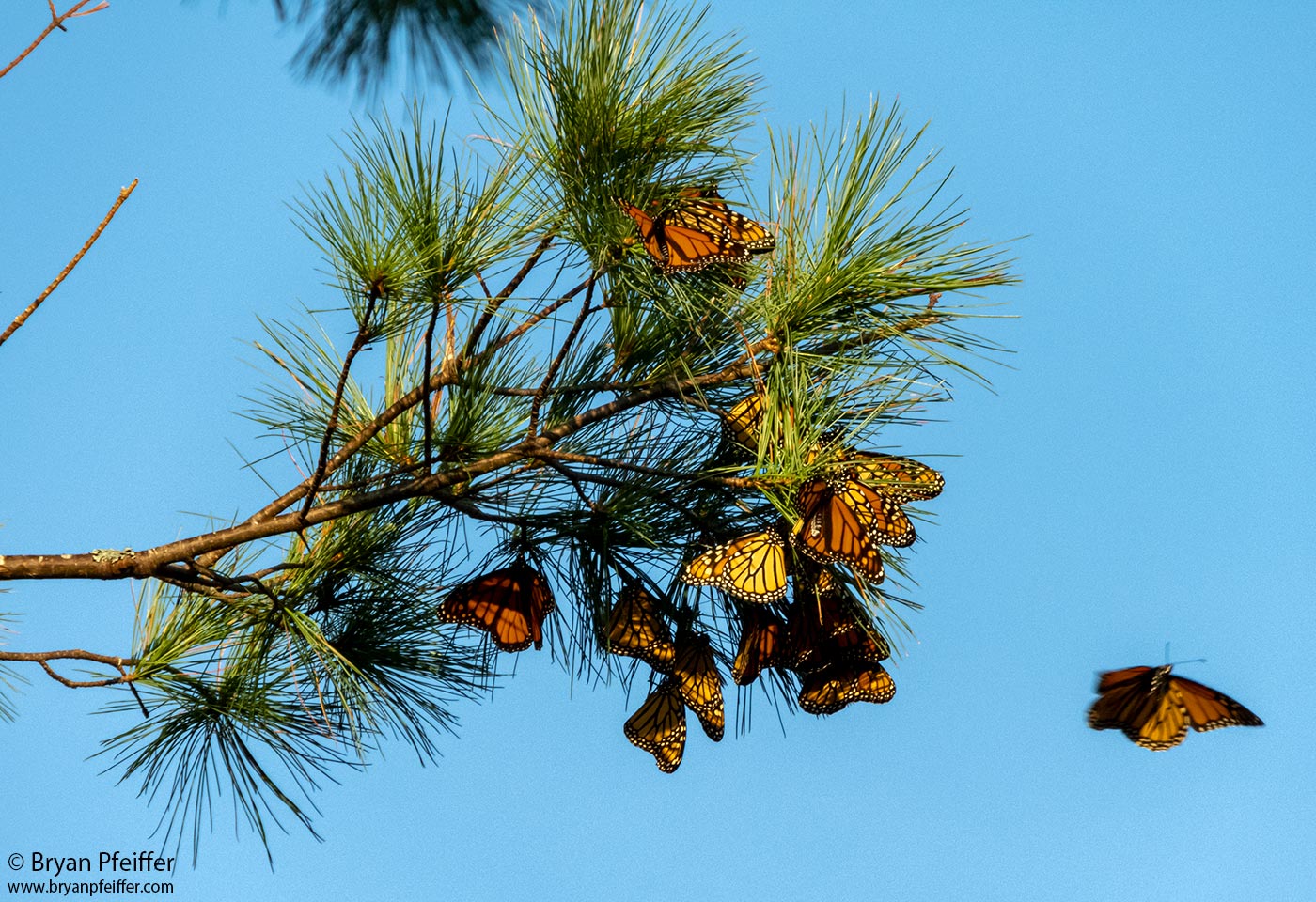
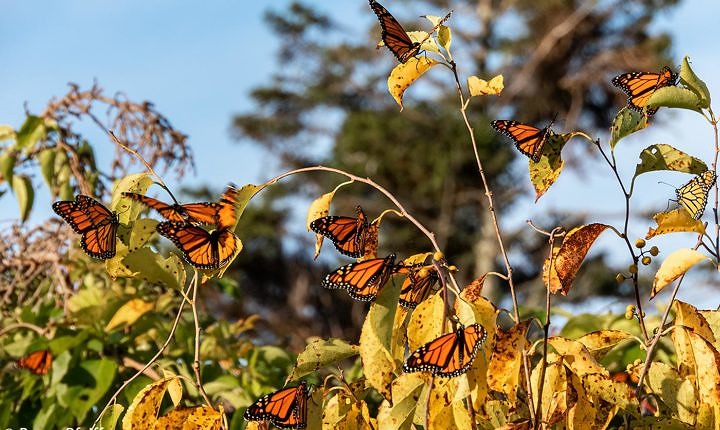

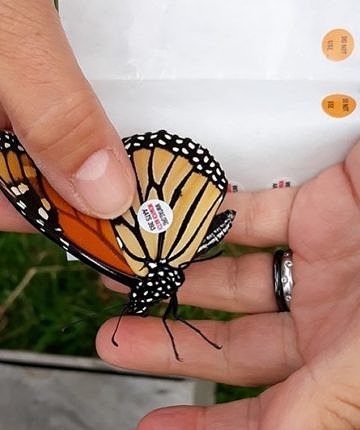

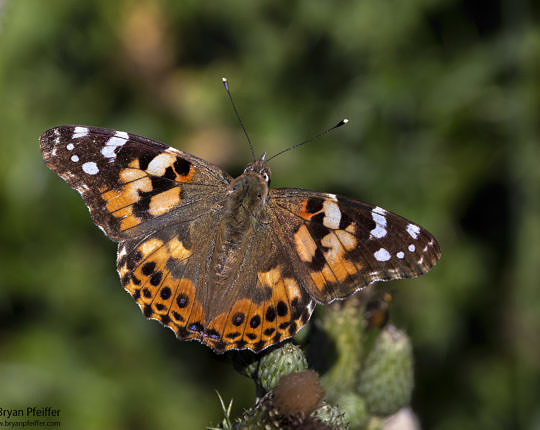
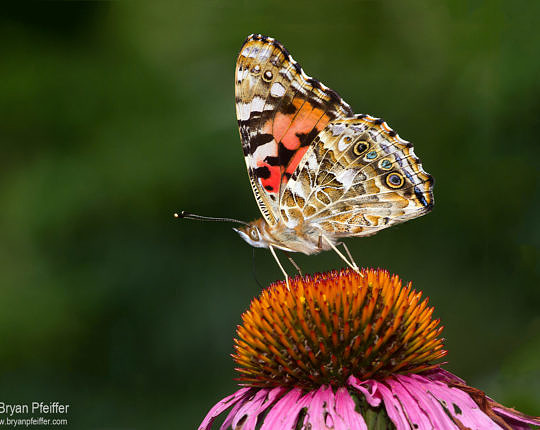
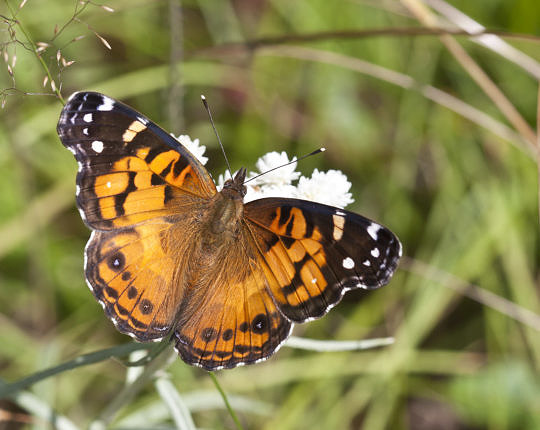

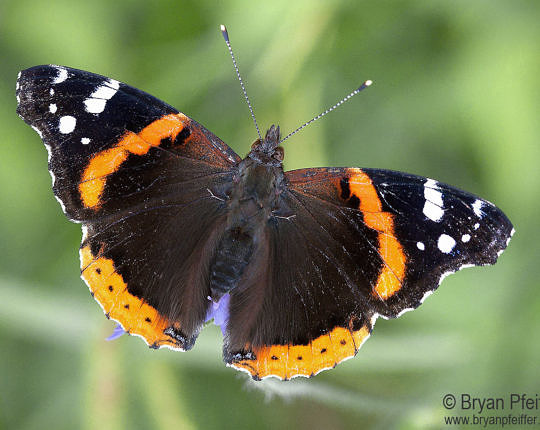
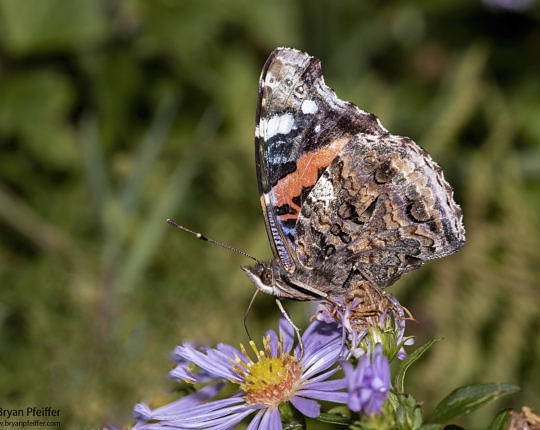

Hi Bryan, After a recent conversation with a friend about how much I love butterflies, he told me about this place. But, I’m not seeing any current comments, I’m wondering if things have changed now on Monhegan with the butterflies?
Ah, so it was, so it was. Thanks, Laura!
I was there. It was like a fairy tale.
Hi Sandra,
In all likelihood, you can leave them outside if there will be nectar sources for the adults. I tend to let nature take its course in these situations. And Monarchs in Florida are in many respect “different beasts” than they are up here. Yes, there’s big concern about them in Florida (as in many places). But there’s also a year-round population in Florida. Yours might be members of that population. I’m not sure. But the folks at the McGuire Center in Gainesville should have more insight than I do. Here’s more about Florida Monarchs: https://www.floridamuseum.ufl.edu/science/florida-monarch/
The batch of Caterpillars I posted about on September 26th resulted in 2 successful releases. Then on October 13th I spotted a single female laying eggs on some potted milkweed plants. So I put the plants in the butterfly houses and those eggs resulted in 7 successful chrysalises. I expect them to hatch starting November 7th with the last one to hatch closer to November 14th. I’m concerned because we are getting cooler weather and since this is only my second year rearing Monarchs, I’m not sure what I can do to give these last 7 a good chance at survival. Any suggestions? I have moved them indoors as temps will be in the mid 50’s tonight here in North central florida. What’s the ideal temp for them? Thanks.
Hi Bryan just a final update for the year, our last late bloomers are either ready to fly or will be very shortly on oct 16th. A whole bunch from this area headed out in the unusually good weather we have had in the second week of oct, unfortunately right into the bomb cyclone hitting new England today. Wish them luck.
We did finally see a few males in the last group but only a few.
The last group had a much higher fail rate maybe 5% rotting in the chrysalis, found a fly maggot in one cage. Some bad wings happened, falling off the chrysalis shell wet can be a real problem for them as they land on this back and can not recover on a floor to climb back up, then their wings set wrong.
I assume different problems increase later in the season.
Also saw a difference in how they act after coming out later in the fall, earlier ones hang around often for a couple days before any attempted flight then hang around on the flowers and enjoy themselves for a few days. In Oct. they are ready for flight faster, and are often headed out within 48hrs if the weather is right on warmer sunny days. Of course all the food is gone.
As for not migrating if raised in non commercial captivity, we move ours about 10 miles to our house as caterpillars then raise them on open porches until it gets really cold. We have large numbers of flower available to maintain them if they desire once out, it is very clear they have a strong urge to migrate, pretty rapidly they leave our yard. Their actions and timing appear to be identical to the group that come out without help in our Christmas tree fields. We commonly see them already ordinated south west leaving the fields.
Hopefully they have a good winter and this does not turn out to be a one year wonder.
Thanks, Bob. Lots to parse here. But one thing to remember is that the northbound migration happens over the course of multiple generations. And a Monarch showing up early on Nova Scotia, way north of Vermont, can happen before we find them here. It’s been fairly consistent over the years — we see our first Monarchs trickling north up here by early June or so. Nope, one female doesn’t lay eggs all of the same sex. 🙂
Thanks for that link, Amy. This is an important study. But to clarify: the problem arose in Monarchs from commercially raised-and-sold larvae. We’re still not entirely sure about the fate of wild larvae reared by ordinary folks. Yep, it’s a red flag — but more work needs to be done on this.
Recent research shows that monarchs raised inside do not migrate. I put netted tomatoe cages around them outside to protect them from predators.
https://amp-theatlantic-com.cdn.ampproject.org/v/s/amp.theatlantic.com/amp/article/592423/?amp_js_v=a2&_gsa=1&usqp=mq331AQCKAE%3D#aoh=15705518067641&referrer=https%3A%2F%2Fwww.google.com&_tf=From%20%251%24s&share=https%3A%2F%2Fwww.theatlantic.com%2Fscience%2Farchive%2F2019%2F06%2Fhand-reared-monarch-butterflies-dont-migrate%2F592423%2F
Bryan just an couple observations, I checked the last dozen or so that we released in Vermont all are females. We have another 50 that are not out yet, will let you know if the females continue. Maybe 1 mother only lays one sex ?
This spring, I saw a post somewhere that said the first monarchs had showed up in Nova Scotia about 500 miles north east of VT, they were not seen in northern VT until sometime later, which was a surprise to me. Maybe the coastal ones that you see have different wind patterns or maybe they started in Florida, but to get to nova scotia first I assume they would have needed to go south of VT over the ocean . The normal wind patterns usually come from Texas to VT then on north easterly to Nova Scotia. Wonder how many are just blown out to sea.
It is clear that mother nature spreads out the returning group to allow the best chance of survival, observed large numbers heading south on sept 30th, unfortunately in the last couple days the flowers and weather are pretty well shot for the new ones, hopefully they have a reasonable chance, I would estimate 20% are still in process here, hard frost in many areas last night.
Thanks, Ernest. This means a lot to me coming from you. I’m gathering more data on these off-shore sex ratios.
Thanks, Barbara!
Bob, This is incredible! I have indeed seen Monarchs emerging in good numbers in October at our latitude. I wonder if you’re tagging? Or at the very least it might be interesting to track sex ratios on your “crop” of Monarchs. And let’s be in touch about this for next year?
Thanks for the very nice (and wonderfully well written!) report, Bryan. You raise good questions about the sex ratio. Given recent trends, the abundance of monarchs in the northeast this year is encouraging.
response to Bob White:
Outstanding work at the Christmas tree farm in Essex! You’ve put so much thought into it, adapting as you notice things along the way. Thank you for the work you’re doing!
Wow, that’s great to hear! Thanks for what you’re doing for our world!
Bryan and all thank you for sharing
At our Christmas tree farms in Essex VT the predators were extreme, massive amounts of eggs and small ones were wiped out on the first round which was very depressing. On the second round the predators backed off and matures could be found everywhere. Milkweed mixed in with mature Christmas trees are a Hugh attractor for the butterfly’s to lay eggs in. Found the caterpillar’s commonly use the trees I believe for safety climbing up into them often. All chrysalis are made in the trees, but maybe they just like climbing. When we mow between the rows we check all milkweed first, in one small field we removed over 300 and raised them, and still the field is loaded in butterfly’s now. About 50% of these are still in the last stage of chrysalis and hopefully will be out by the 1st of OCT. If this is not uncommon there are a heck of a lot more coming, and we have more then I have ever seen nectaring already. We have about 70 acres of fields spread out around our properties, dedicated to monarchs and nature but get more activity in a 10 acre mature Christmas tree field then all the others combined, they wanted 8 foot plus trees, other fields with smaller trees had much less activity this year..
Just hope they get the right conditions for a safe journey this fall.
I will, Bryan. Thanks again for a great article
They’re nectaring bigtime on goldenrod and asters here on Monhegan.
Yes, indeed — you must have been busy, Barb! In the meantime, watch for some tagged Monarchs flying your way. 🙂
I’ll be investigating that trends a bit more, Nena. Thanks.
We spent some time with Lisa and Ed! 🙂
Lots of ode migrating as well, Sally!
Hi Mark
I don’t believe that to be true. I think that at times, MonarchWatch could do better making data available. But I also know that its data has been tremendously beneficial to many researchers. It has been the foundation of many publications. Here’s but one example: https://pdfs.semanticscholar.org/82d9/36c4a6b93c8a69a05ef166aac90df3470ca7.pdf
And if you go to this page you’ll see where we can query tag recoveries. Lots of data:
https://monarchwatch.org/tagging/index.html#recoveries
Go figure. (We will.) Thanks, Sarah. 🙂
Thanks, Jenny. I do think we need bits of good news like this. It helps us act when the news isn’t so good — and it’s worrisome overall with Monarchs and wildlife in general.
Great story, Timothy. Thanks! Watch the wildflowers now — particularly purple asters if you have them and the coastlines. You should indeed be seeing Monarchs. We’ve got a spectacular migration going here in the East.
Thanks, Jan. You may be able to skip the burlap next year. Birds are a relatively minor threat to Monarch caterpillars.
You’ve been busy, DeeDee. Which swallowtail species are you rearing?
Thanks for the report from the Monarch Heartland, Wanda!
As it turns out, someone did see a tagged Monarch at Popham Beach! Didn’t get a number.
Thanks, Penny. Yes, some big forces are in play when it comes to threats to Monarchs and other wildlife, but I also like the general awareness that rises among people when we rear and release Monarchs.
Watch for Monarch visitors from the north, Sandra! 🙂
Get some of these going. You will have swarms of monarchs. https://monarchbutterflygarden.net/butterfly-plants/liatris-ligulistylis/
I’m in North Central Florida and this was my 1st season rearing Monarchs. Thought the season was over as our last one of 32 was released 3 days ago but today I found many more Caterpillars in the milkweed. So the butterfly houses are back up and we’ll see how many more we can rear to adulthood.
Love your story! I hope one of these little beauties came from my efforts to help, I was able to release 19 healthy Monarchs here in Oxford, ME. If we all keep doing what we are doing, they may actually have a chance 🙂
Small swarms (a half dozen to two dozen) of Monarchs are arriving from the open seas onto the shore here at Popham Beach, ME all week. Have not seen tags, though. I’ll keep looking!
I’m from near Kansas City and planted a native flowerbed (including milkweed) and raised, tagged and released 10 Monarchs. It was a fantastic experience!! Planting more milkweed for next year.
Here in north Carolina I’m still raising swallow tail capterpillars,have 14 in various stages.Released 125 monarchs this year.Most I’ve seen in years.Getting ready for next year definitely planting more milkweed.It was awesome watching them fly away,and a little sad.
This was the first year I noticed monarch catapillers in my garden I covered the butterfly weed they were on with burlap so birds would not eat them. It worked out well. They made their chrysalis on the burlap. I made sure they had enough room to dry their wings by repositioning the burlap. Can’t wait to assist more of these guys now that I know what to look for.
I have lived in Delaware for 46 years and last year I noticed several black and yellow caterpillars. I was like,” what is this”. I’ve never seen them before in my life. So I noticed about 10 of them in my wild flowers, I guess they liked something in them. They were eaten quick all the leaves, crazy. So I then googled Monarch butterfly. There I learned all about this wonderful insect. I was excited to see the Chrysalis, they were under my chairs and on my vinyl siding. Some didn’t form into a butterfly small wings at birth. Some 2 never came out of cocoon. One had small wings couldn’t fly. I was so sad to see this deformality. They would hatch, when I turned my back to see beautiful butterfly flapping its wings to dry, I learned, before they flew away. This year no wild flowers, milkweed plants, maybe next year. I made a garden this year. Will I see the butterflies in DE as they migrate to mexico? I hope so…
Thanks for the posting and I thought the pics were great.
Lifted my spirits to hear some good news about the monarchs.
Jenny
Surprising about the preponderance of males in the article — the butterflies we are releasing here in my portion of CT are almost all females!
I was recently discouraged from tagging monarchs by a DNR staffer because, she said, the org collecting the data wasn’t sharing it. Do you know if that’s true?
Great article and fantastic photos! Well done, Bryan!
We were there until the 15th. Saw lots of monarchs but nothing like this–mostly individuals flitting about. How wonderful for you to be there for this!
That’s fantastic! I just started this year, in NC. I did noticed a higher rate of males in the ones I raised and released.
Central NJ. I germinated & grew milkweed seeds in fall. Mexican Bloodflower grew quickly, bringing Monarch females laying eggs which were raised indoors. Released about 20-25, majority were female (was so busy feeding the cats, lost count). Nothing will compare to the joy of each hatch & release of these beauties. It’s late September, they are on their way South and I’ve already started milkweed seeds to double or triple the effort for next season.
Thanks, Catherine. Yes, in September (even October), Monhegan is heaven.
We see them into December on the Massachusetts coast — the stragglers. A rough trip for them.
Something I must do before I leave this Earth.
See you soon!
It will be nice to see them in Vermont into October — maybe even into “Stick Season.”
Alas, I leave Friday morning. 🙁
Yes, a year to remember, Debbie. Glad you’re enjoying it.
Lovely report, Marjorie. Thanks. Well, I suspect it’ll keep going into October. We’re still getting a few reports of caterpillars and chrysalises here in the north.
Watch for my tags, Kit! 🙂
Hi Judy. Messengers spreading the word!
Beautiful — and determined. Thanks, Joanne.
Hi Karen, Nice to hear from you. If you get to the NH coast, watch for my tags! 🙂
Thanks, Delberta. It sounds wonderful out there!
Thanks, Judy. There are indeed a few publications on this, including evidence of a long-term trend toward fewer females. Here’s one:https://royalsocietypublishing.org/doi/full/10.1098/rsbl.2009.0632
They are on the way, Carol.
Yes, this may not be that unusual, Ruth. I’ll be following up on it. There is some good evidence, however, that these coastal migrants are lighter and smaller than their inland counterparts. More on that later as well.
Monarchs along Lake Michigan — must be quite a sight. I wonder if or where they cross, or whether they bend right toward Chicago.
So wonderful hear another fellow Monarchian contemplating the ways of nature! My first year as a foster rescuer, I have released 18 large, heathy monarchs; 11 males, 7 females. 5 miles east of lake Michigan appx 42°N 86°W. I found your speculations intreguing!
I ‘raised’ several cats this year and was sad that several chrysalis turned black early and did not eclose. That said, the majority of those that I did see were females. I note that same with those I can sex while flying south.
I am in Denton, Texas, anxiously awaiting their arrival. They are such beautiful creations of God.
This is a great report on a favorite insect – thank you!
A note regarding the male vs female monarchs…I enjoyed “hatching” monarchs with second graders from 1967-2006, perhaps a few through a dozen a year, and continue to raise a few each year, just for the magic of it. In all those years, we noted males outnumbering females about 2 to 1. We came up with theories about this…possibly the males being somehow weaker/more prone to disease, etc. Any reason males would migrate earlier than females? Intriguing questions! Happy butterfly watching!
This is so wonderful! My daughter has a waystation here in Illinois, she has released 95 as of this writing. With 5 chrysalides left to emerge. I have released 33. 19 males and 14 females. It has been so rewarding. She is planting more fall flowers to feed them. I have started a 2 acre milkweed and wild flowers habitat for all pollinators. So glad that they are doing so well this year!
Bryan, this has been a good year in NH. Many are still flying about in Lyme and in Norwich, VT at the end of this month. We visited them in their winter site in Mexico last Feb and feel we know them now as they decorate our landscape up here in the north. Hopefully yours know where they are going from Monhegan!
I raised some the last 2 years and had more males than females also. They are such beautiful little creatures.
On Friday I watched five monarchs fly south on Burlington’s Church Street above our signs protesting climate change.
I am birding on the coast of NH and we are amazed at the huge number of monarchs we have seen today. Maybe ones that have left Monhegan since they were all coming inland from the ocean.
From a snowy winter day in Nulhegan Basin photographing a 3 toed woodpecker to the White Mountain area withMonarchs. I have watched my horseless fields of Milkweed and Goldenrod host their life cycles. Yesterday one flew beside my car down my driveway as I exited. Such beauty
Could not help but wonder if this special treat has come to closure this year as I add layers of clothing to go out amongst the reds, oranges, greens of our moving into the next season!
Thanks for the up date on the monarch’s, I’m on Lake Carmi Franklin, Vt. and we’ve been seeing more than ever.
Keep those Monarchs and birds for a few more days. I will arrive tomorrow with VCE.
There’s many up here in VT that are starting to make the journey. I send them on their way w/ a “Thank you & Safe Journey”.
I’ll be on monhegan Friday – will they still be there? How about you, Bryan?
I saw them in Michoacán in Mexico, last end of February, swarming to migrate back to Texas. A bucket list view.
What a pleasure to read this, Bryan! I was just in Falmouth on Cape Cod & also saw quite a few Monarchs, as well as American Ladies. I’ve seen few of either in New York state, this year.
Thank you for a wonderful report from Monhegan. I so want to do this September trip one of these days! Your post and photos took me there, so thank you.